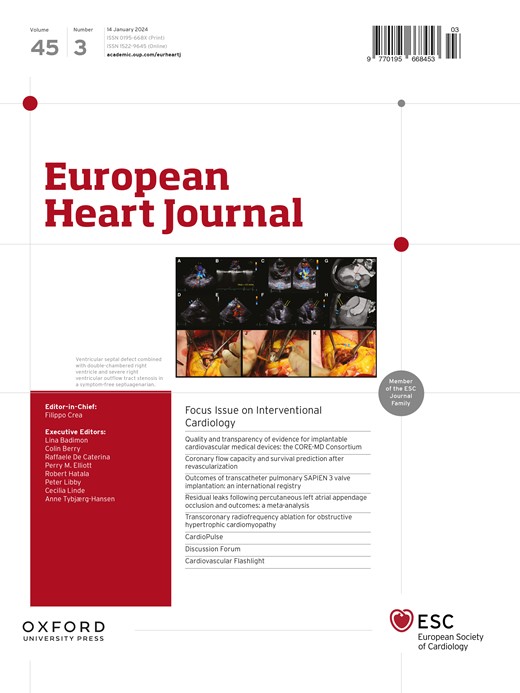斑块裂和钙化结节:组织病理学表现
IF 35.6
1区 医学
Q1 CARDIAC & CARDIOVASCULAR SYSTEMS
引用次数: 0
摘要
冠状动脉疾病仍然是发病率和死亡率的主要原因。精确定义导致冠状动脉疾病的不同斑块形态对于全面了解斑块进展和易损性至关重要。这篇综述澄清了关键的和经常混淆的斑块表型:具体地说,斑块裂vs破裂,钙化结节vs结节钙化。此外,它通过检查变化的急性冠状动脉综合征的表现和进化的罪魁祸首病变形态来介绍这些病理,并探讨先进的冠状动脉成像技术如何彻底改变其检测和治疗。斑块裂隙的特征是偏心病变的外侧撕裂,穿过厚纤维帽,最终形成小的坏死核心。与破裂相反,裂缝伴有斑块内血栓,通常由纤维蛋白、血小板和红细胞组成,而管腔血栓通常不存在或很小。破裂时,薄纤维帽被破坏,并伴有巨噬细胞和t淋巴细胞的显著浸润。钙化结节是纤维蛋白穿插的致密钙碎片,突入血管管腔,引发通常由纤维蛋白和血小板组成的非闭塞性管腔血栓。钙化结节典型表现为偏心病变,管腔表面呈凸状,缺乏纤维组织或内皮。结节状钙化形态相似,其上厚纤维帽完整,内衬内皮细胞,无血栓。澄清这些基本差异对于提高对冠状动脉疾病发病机制的理解和制定个性化治疗策略至关重要。本文章由计算机程序翻译,如有差异,请以英文原文为准。
Plaque fissure and calcified nodule: histopathological findings
Coronary artery disease remains a leading cause of morbidity and mortality. Precise definitions of the distinct plaque morphologies that contribute to coronary artery disease are essential for a comprehensive understanding of plaque progression and vulnerability. This review clarifies critical and often conflated plaque phenotypes: specifically, plaque fissure vs rupture and calcified nodules vs nodular calcification. Furthermore, it contextualizes these pathologies by examining shifting acute coronary syndrome presentations and evolving culprit lesion morphologies and explores how advanced coronary imaging technologies are revolutionizing their detection and treatment. Plaque fissures are characterized by a lateral tear in an eccentric lesion that traverses a thick fibrous cap and ends in a small necrotic core. In contrast to ruptures, fissures are accompanied by an intraplaque thrombus, typically composed of fibrin, platelets, and red cells, while luminal thrombus is usually absent or small if present. In ruptures, a thin fibrous cap is disrupted and associated with significant infiltration of macrophages and T-lymphocytes. Calcified nodules are fragments of dense calcium interspersed by fibrin that protrude into the vessel lumen and trigger a luminal thrombus that is usually non-occlusive and composed of fibrin and platelets. Calcified nodules typically appear as eccentric lesions with a convex luminal surface that is devoid of fibrous tissue or endothelium. While nodular calcifications have a similar morphology, the overlying thick fibrous cap is intact, lined by endothelial cells, and devoid of thrombus. Clarifying these fundamental differences is crucial for an improved understanding of the pathogenesis of coronary artery disease and developing personalized treatment strategies.
求助全文
通过发布文献求助,成功后即可免费获取论文全文。
去求助
来源期刊

European Heart Journal
医学-心血管系统
CiteScore
39.30
自引率
6.90%
发文量
3942
审稿时长
1 months
期刊介绍:
The European Heart Journal is a renowned international journal that focuses on cardiovascular medicine. It is published weekly and is the official journal of the European Society of Cardiology. This peer-reviewed journal is committed to publishing high-quality clinical and scientific material pertaining to all aspects of cardiovascular medicine. It covers a diverse range of topics including research findings, technical evaluations, and reviews. Moreover, the journal serves as a platform for the exchange of information and discussions on various aspects of cardiovascular medicine, including educational matters.
In addition to original papers on cardiovascular medicine and surgery, the European Heart Journal also presents reviews, clinical perspectives, ESC Guidelines, and editorial articles that highlight recent advancements in cardiology. Additionally, the journal actively encourages readers to share their thoughts and opinions through correspondence.
 求助内容:
求助内容: 应助结果提醒方式:
应助结果提醒方式:


